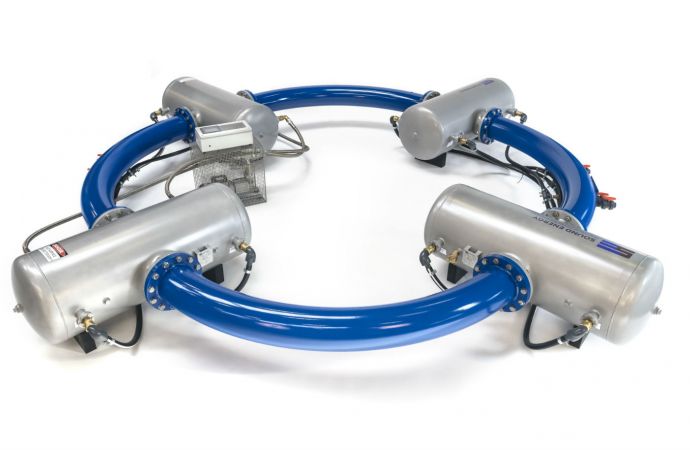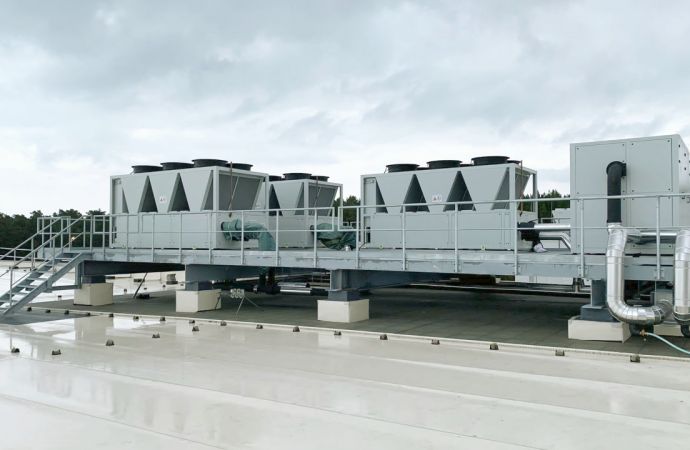Dutch start-up SoundEnergy uses thermoacoustics to change waste or solar heat into cooling, without refrigerants or vapor compression.

THEAC25
Sound Energy, based in Enschede, the Netherlands, has developed a compressor- and refrigerant-free unit capable of delivering cold as low as -25°C (-13°F), using only waste heat, and requiring almost no energy input.
This might sound like a fairy tale, but the system, THEAC-25, works using long known principles of thermoacoustics and the Stirling Cycle. And it is already being deployed by several end users.
The device utilizes the fact that heating a gas leads to increased pressure, meaning that one can use a temperature differential to create a pressure differential. This can, in turn, be used to create a sound wave, which essentially is a wave of compression and rarefaction. This wave is then amplified and the resulting mechanical energy can be turned into cooling. The heat transfer has an efficiency of 40%-50%, the company said.
In a February 2019 article in Forbes, SoundEnergy CFO Roy Hamans explained the system as follows: "We take thermal energy ... [and] we transform this thermal energy into an acoustic wave. This wave travels through a pressurized infinite loop in which it continues to be amplified.
" This huge mechanical power,” he continued, “will be transformed into a delta T [lower temperature] down in the last two vessels [of the unit] by connecting them in reverse."
The complex process is only fully understood by “two or three dozen people globally, all experts in thermoacoustics,” he added.
The device can be used for air conditioning in a variety of building spaces, as well as cooling for packing and production processes, and for maritime projects like military vessels and even cruise ships.
According to Forbes, SoundEnergy began shipping THEAC-25 commercially in September 2018. One of the first customers was the government of Dubai, which bought a unit to cool a plant that condenses drinking water from the air. IKC Magenta, a child care center in Delden, the Netherlands, has installed the system for comfort cooling.
In 2019 SoundEnergy “got a lot of traction” in the food-and-beverage sector (such as bakeries and coffee roasting companies), heavy metal companies (die cast and metal hardeners), hydrogen production, off-grid applications like expeditionary compounds, and marine off-shore applications, SoundEnergy CEO Herbert Berkhout told Accelerate Magazine. “ These amazing market segments show growth year-by-year and have a large cooling need.”
Waste heat and sunshine
THEAC-25 can utilize waste heat such as that from a plant or production line. The minimum required heat-source temperature is 160°C (320°F), and the maximum input temperature is 300°C (572°F).
The minimum heat requirement means that normal solar panels don’t work as a heat source, but vacuum solar collectors can provide the needed temperature, according to SoundEnergy’s website.
The company’s prototype unit is 4-by-4 m wide (13-by-13 ft) and about 80 cm (31 in) high, and weighs 1,100 kg (2,425 lbs). It uses the noble gas argon to create the acoustic wave.
The prototype is capable of producing a 25- kW (7.1-TR) cold output, at a temperature as low as -25°C (-13°F). It does all this very silently, producing only around 70 dBa of noise.
Apart from providing cooling, THEAC-25 can also be used to generate heating and function as a heat transformer.
A device the size of the prototype will cost around $50,000, but prices are expected to drop once production scales up, and lower prices are available to residential users. The system itself is scalable, both up and down in size. The company has created a demonstration unit that fits into a 20-ft shipping container.
The initial cost is partly offset by the fact that THEAC unit uses no electricity at all. It does, however, require three pumps to circulate the heat-bearing and cold-bearing fluids, a controller, and a dry cooling system. According to the SoundEnergy website, these use approximately 2 kW of electricity in total. The unit requires only an annual inspection.
THEAC has an expected lifespan of 20-30 years, and the systems pay for themselves, according to Hamans. "For commercial and industrial use we are talking about only a few years to five years payback time," he told Forbes.These amazing market segments show growth year-by-year and have a large cooling need” - Herbert Berkhout, SoundEnergy
Related stories



